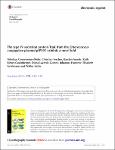The type IV secretion protein TraK from the Enterococcus conjugative plasmid pIP501 exhibits a novel fold
Goessweiner-Mohr, Nikolaus
Fercher, Christian
Arends, Karsten
Gruenberger, Ruth Birner-
Gomez, Diana Laverde-
Huebner, Johannes
Grohmann, Elisabeth
Keller, Walter
Conjugative plasmid transfer presents a serious threat to human health as the most important means of spreading antibiotic resistance and virulence genes among bacteria. The required direct cell-cell contact is established by a multiprotein complex, the conjugative type IV secretion system (T4SS). The conjugative core complex spans the cellular envelope and serves as a channel for macromolecular secretion. T4SSs of Gram-negative (G-) origin have been studied in great detail. In contrast, T4SSs of Gram-positive (G+) bacteria have only received little attention thus far, despite the medical relevance of numerous G+ pathogens (e.g. enterococci, staphylococci and streptococci). This study provides structural information on the type IV secretion (T4S) protein TraK of the G+ broad host range Enterococcus conjugative plasmid pIP501. The crystal structure of the N-terminally truncated construct TraK was determined to 3.0 resolution and exhibits a novel fold. Immunolocalization demonstrated that the protein localizes to the cell wall facing towards the cell exterior, but does not exhibit surface accessibility. Circular dichroism, dynamic light scattering and size-exclusion chromatography confirmed the protein to be a monomer. With the exception of proteins from closely related T4SSs, no significant sequence or structural relatives were found. This observation marks the protein as a very exclusive, specialized member of the pIP501 T4SS.
No license information

